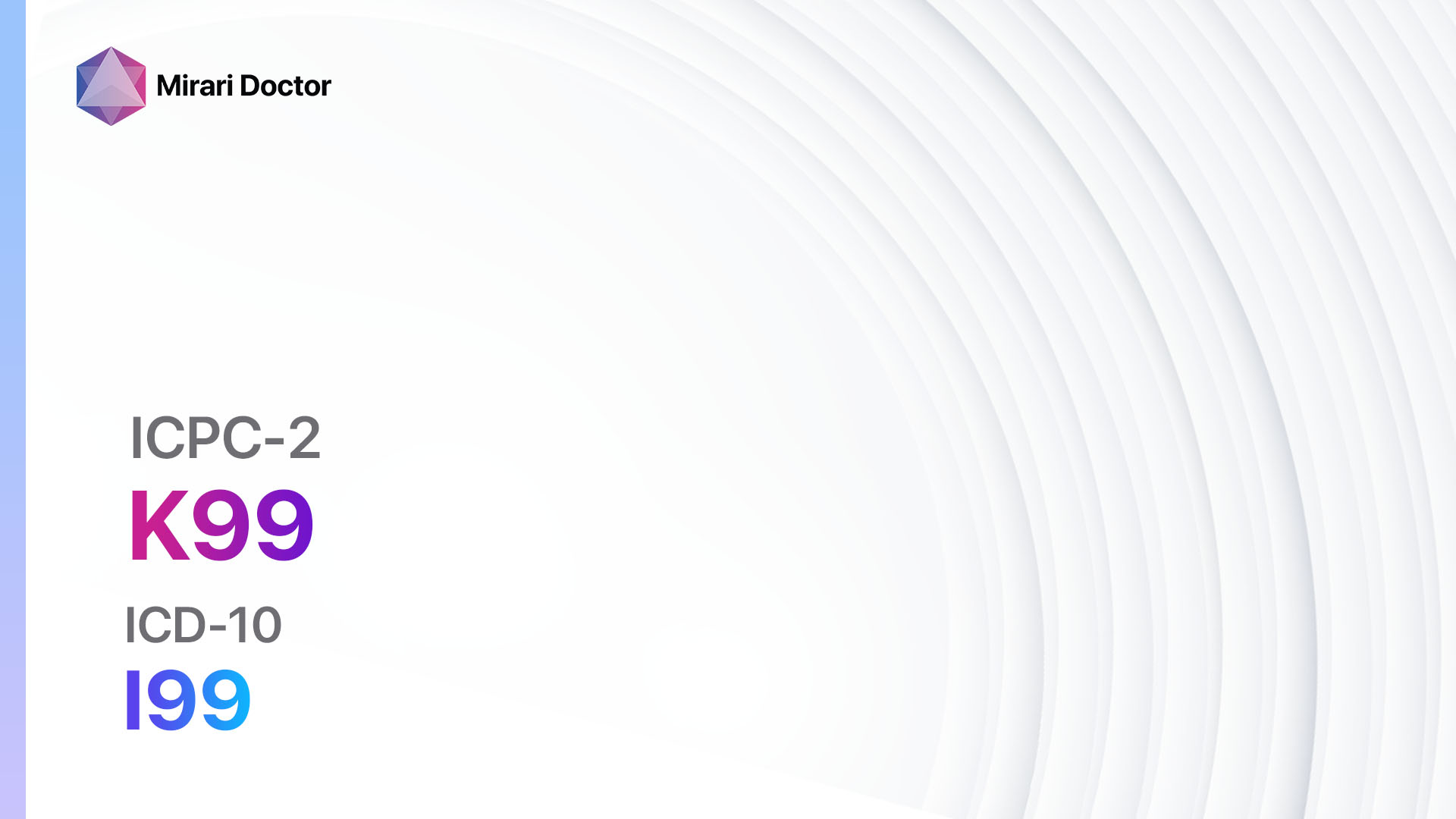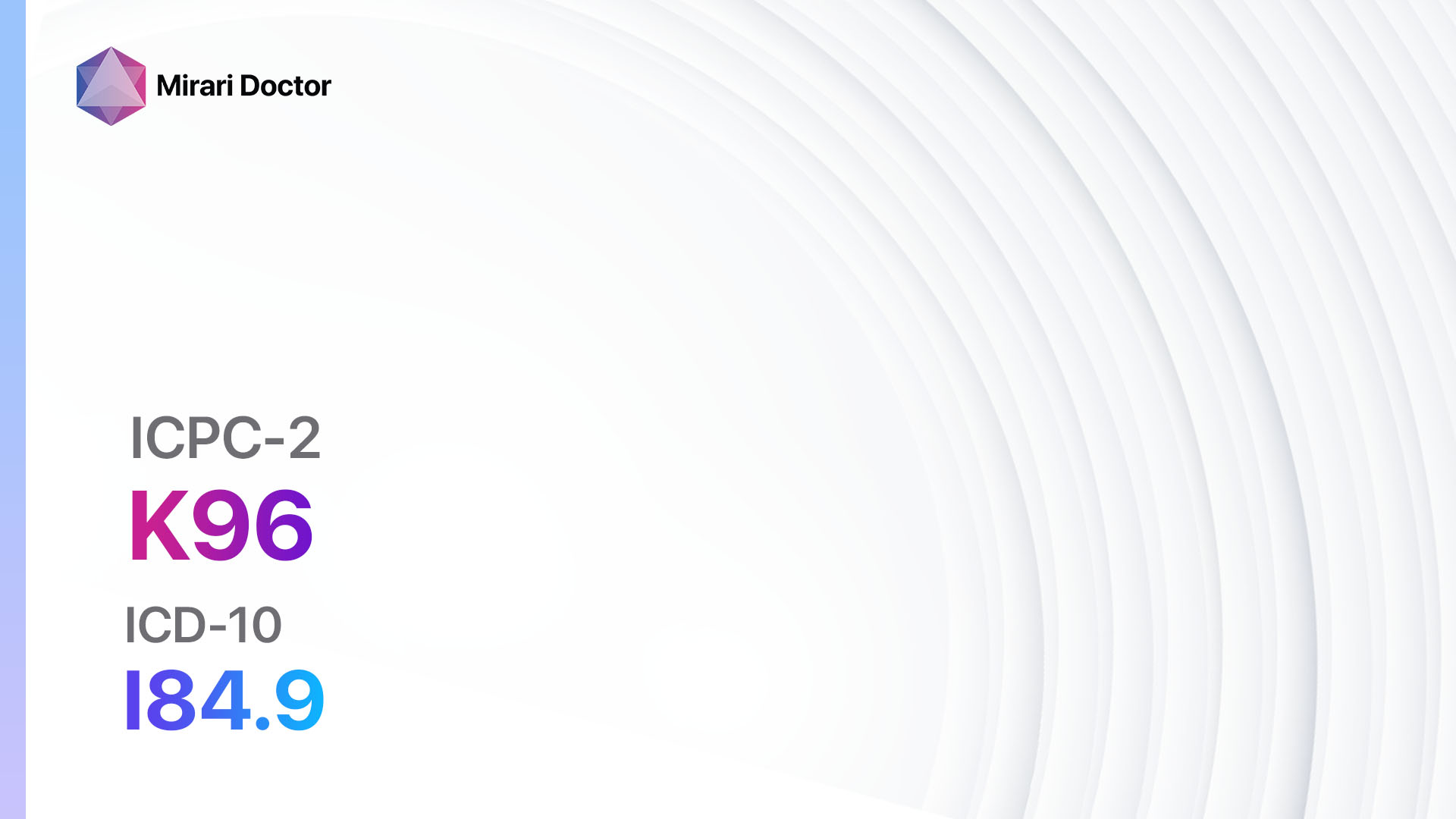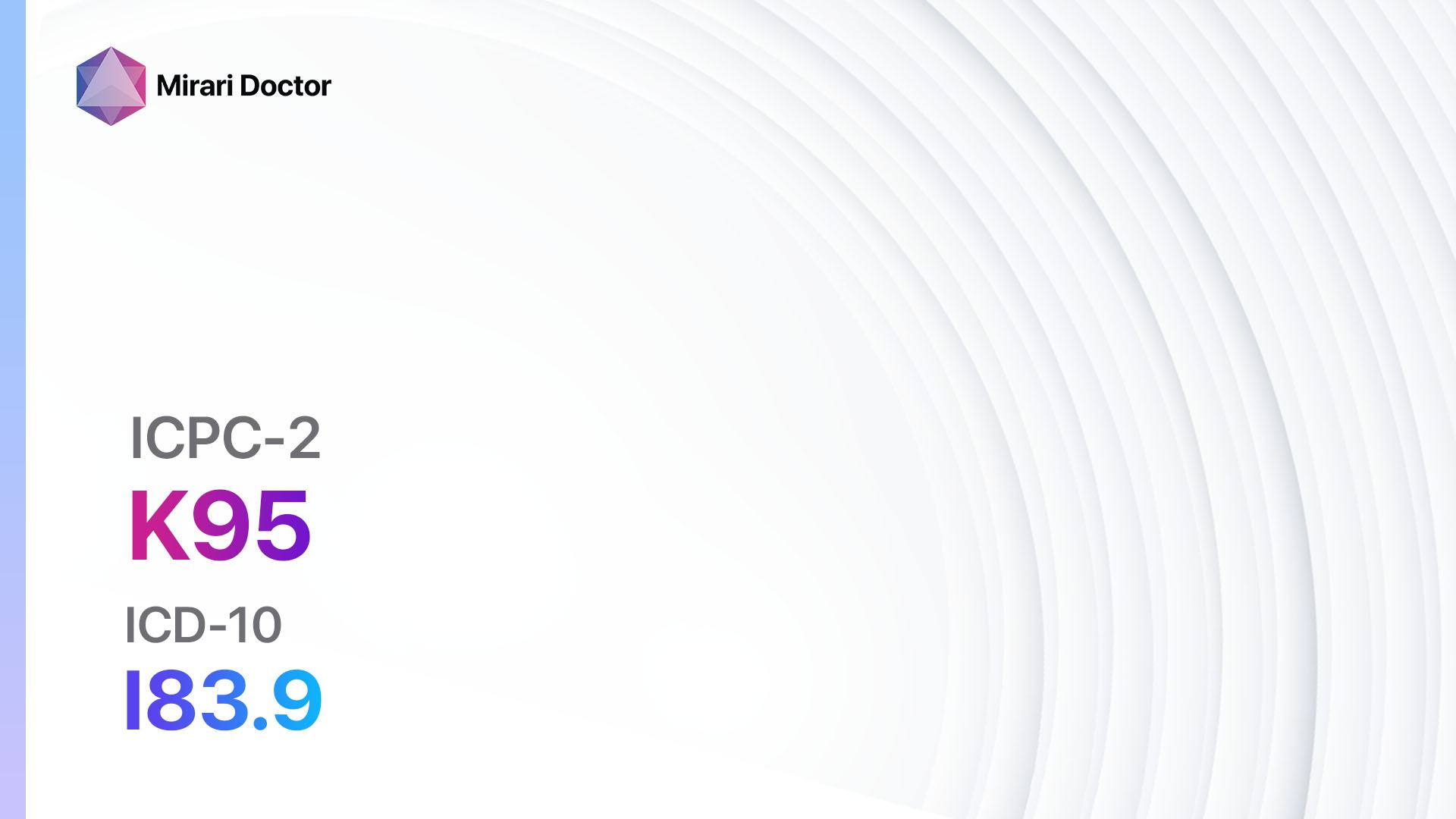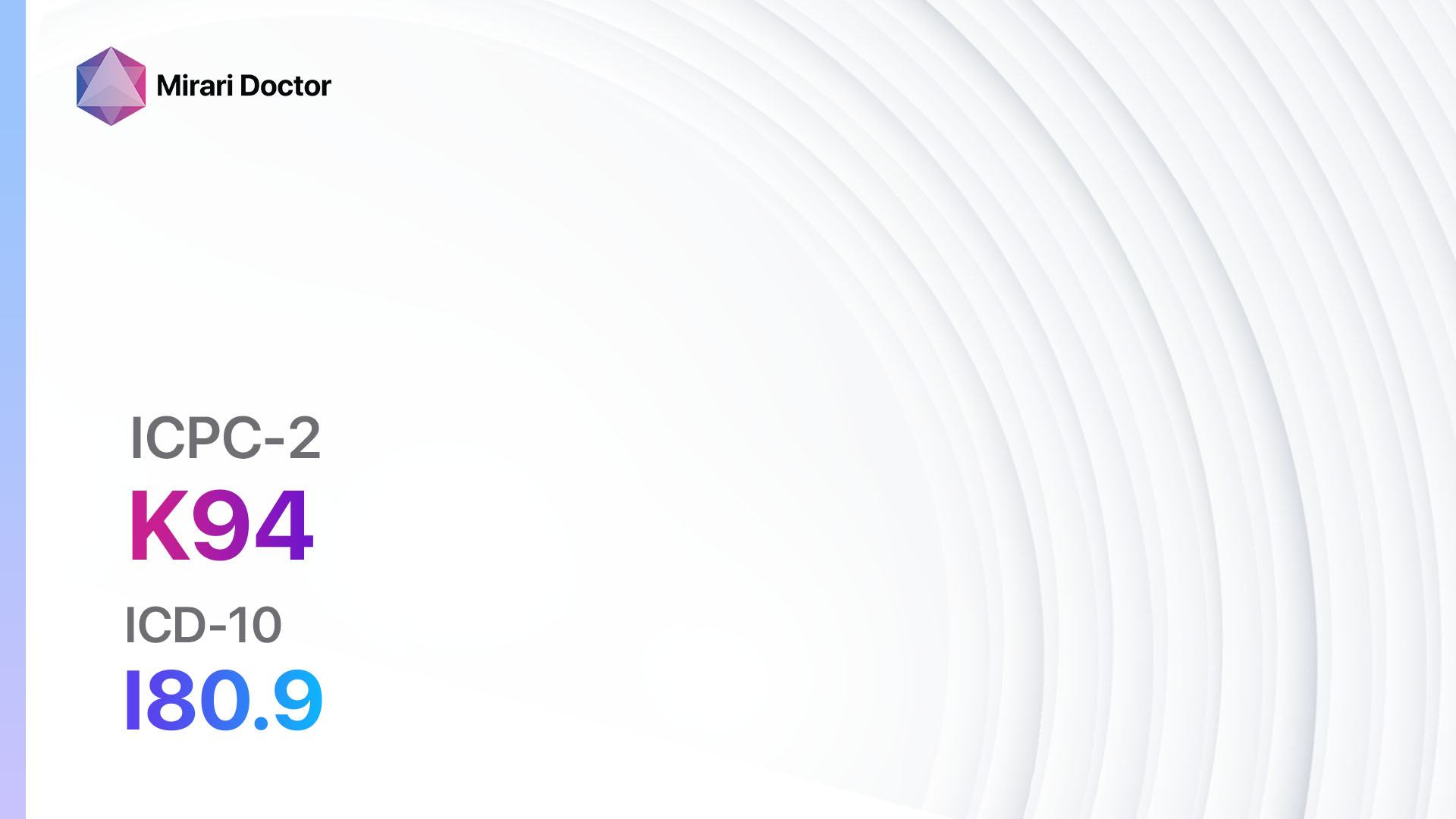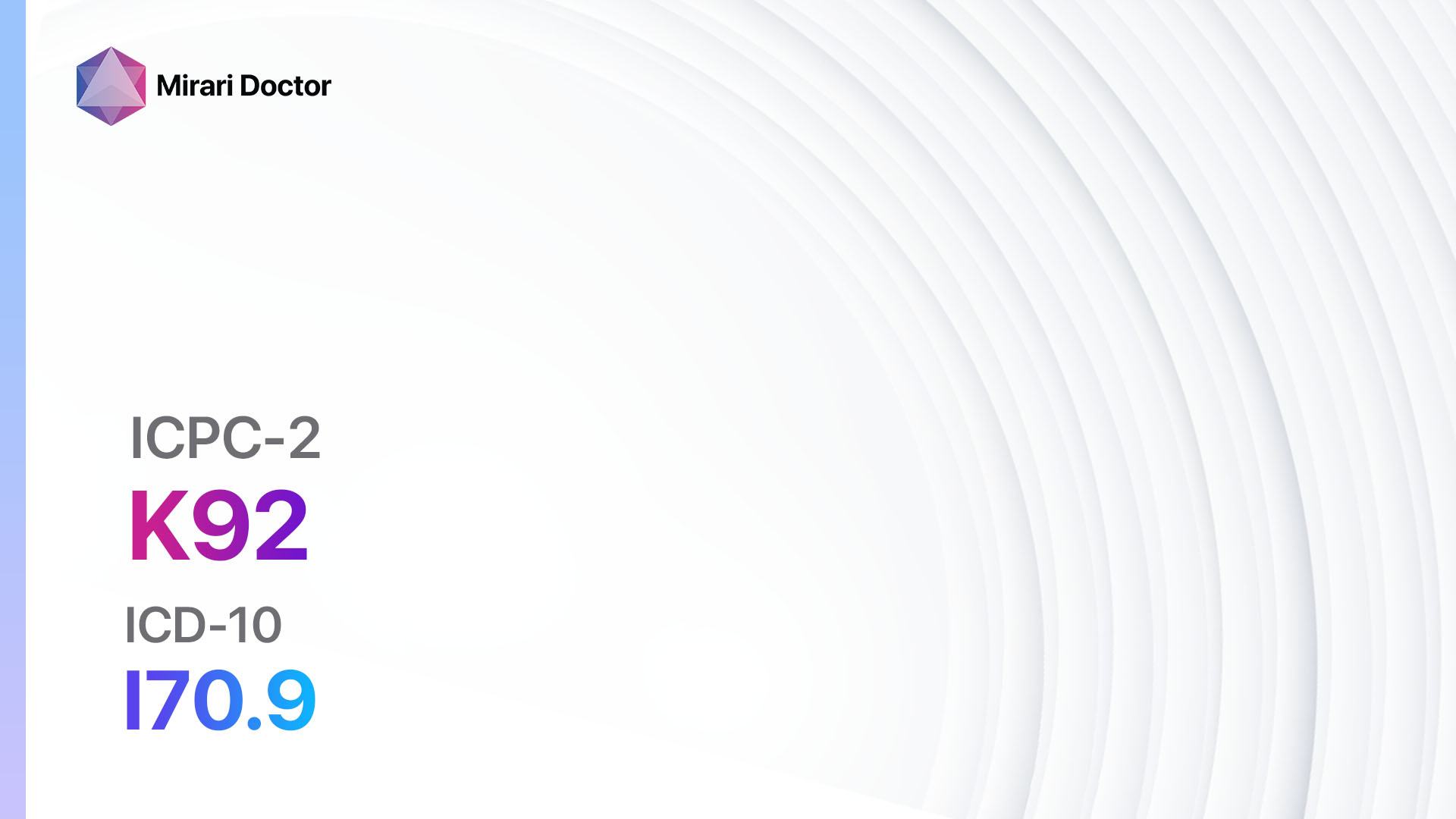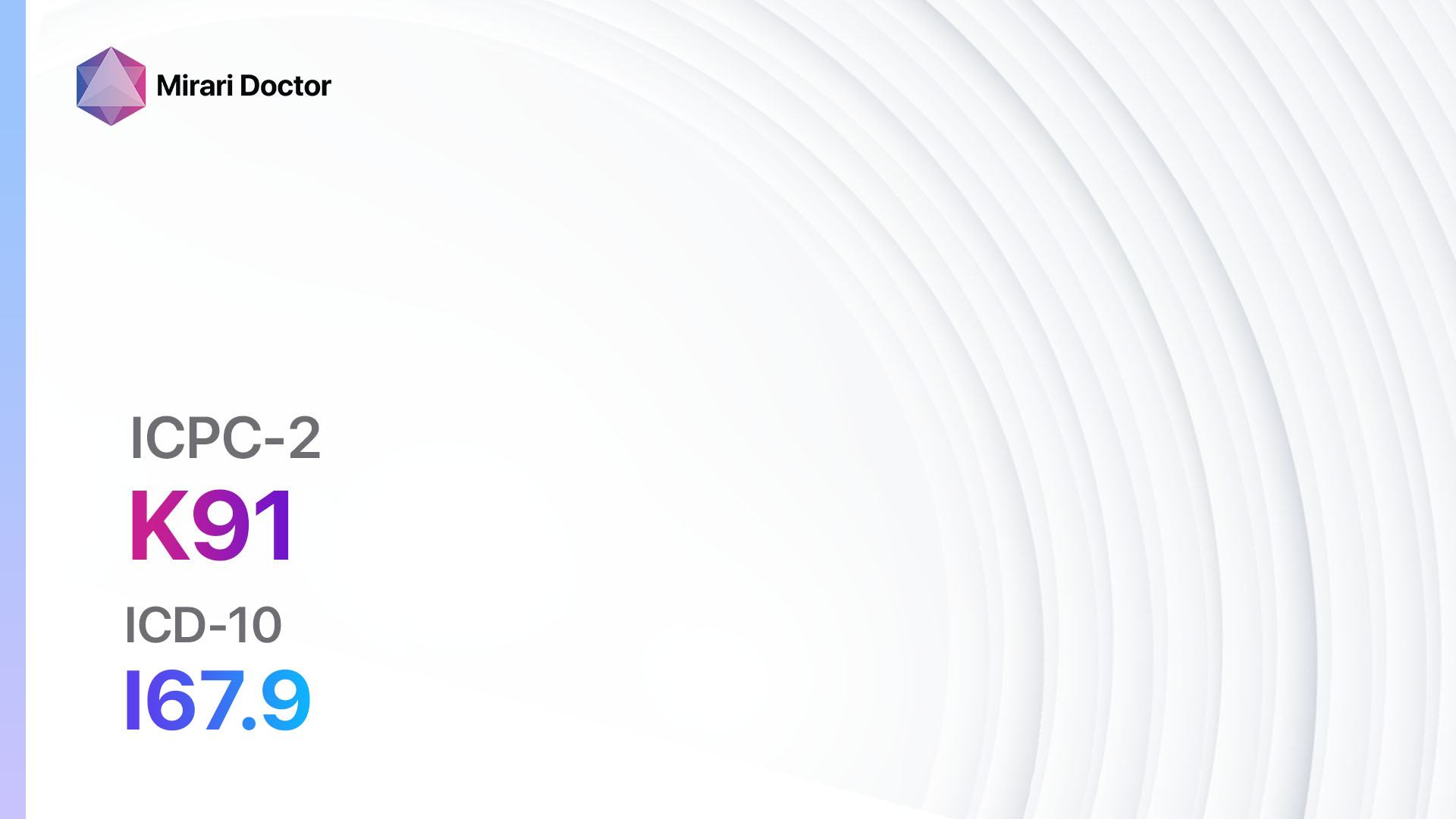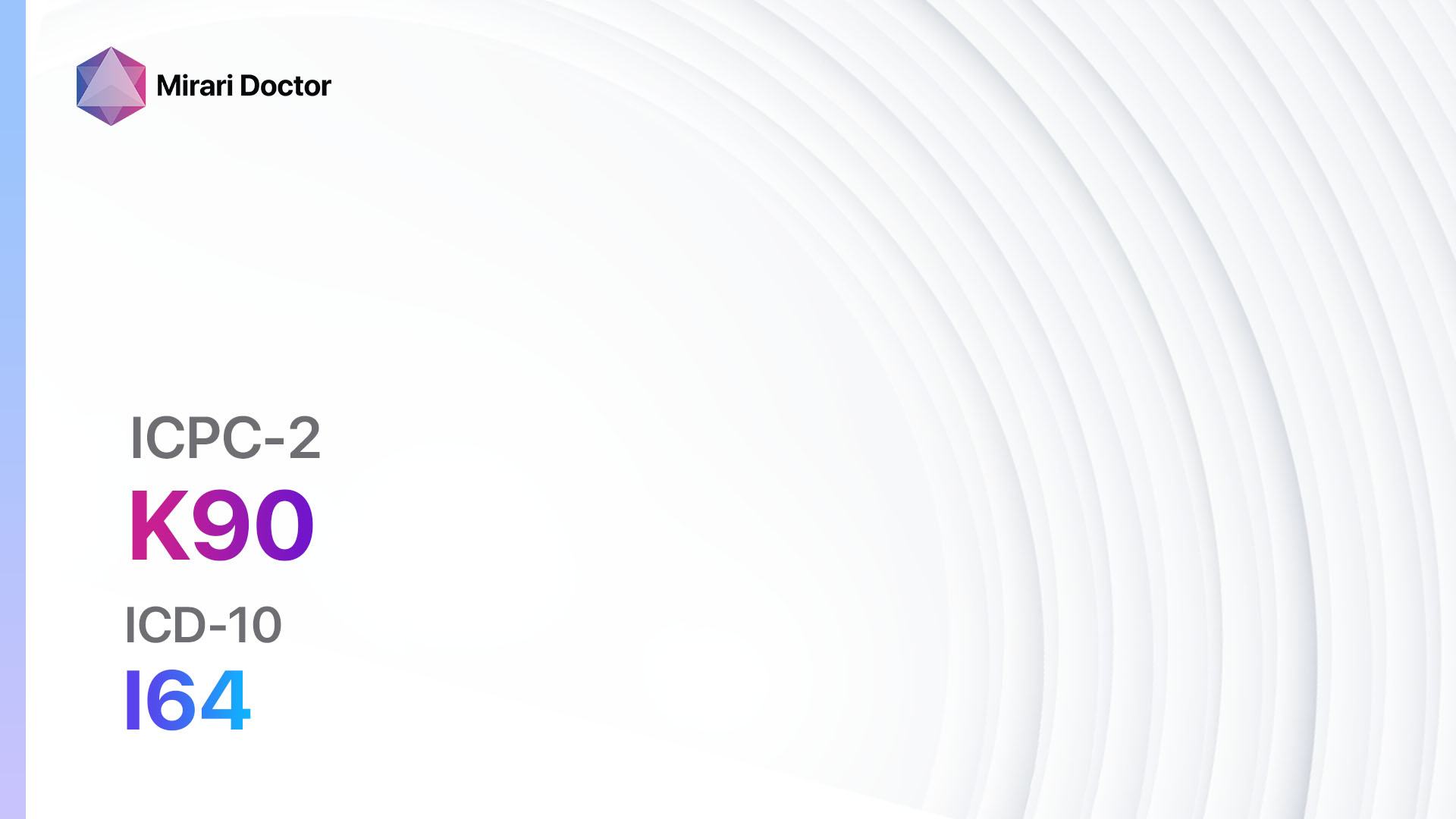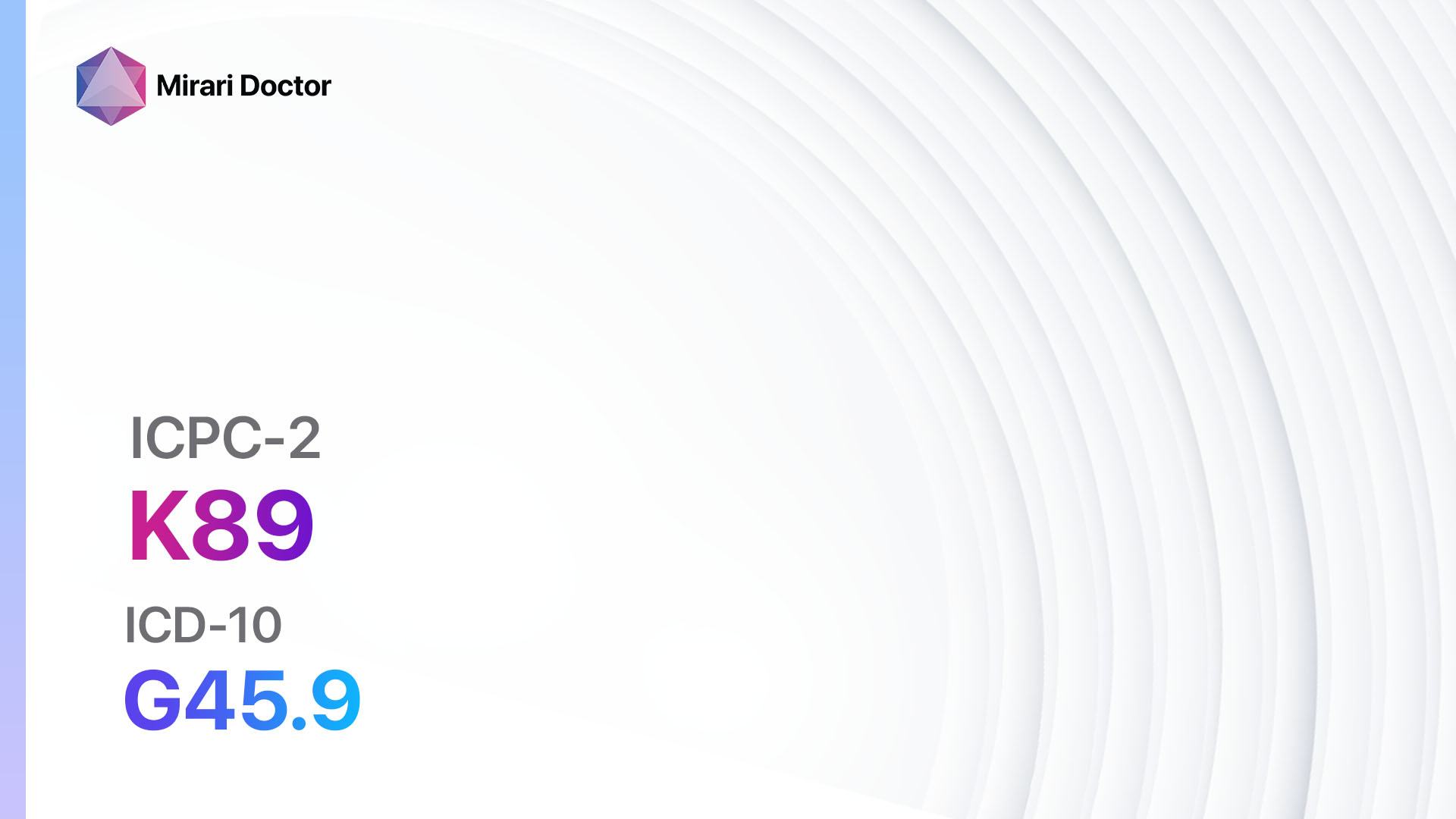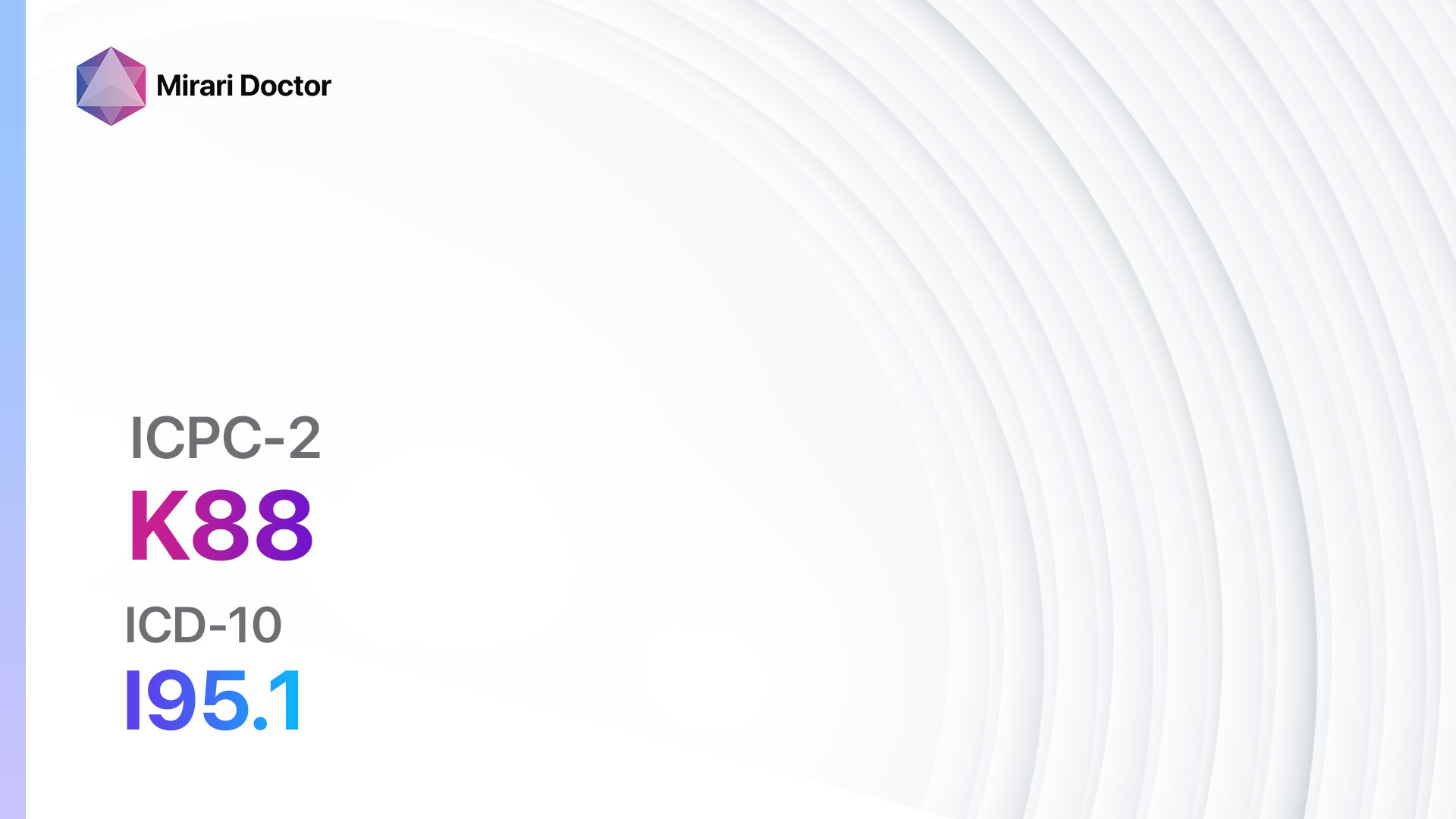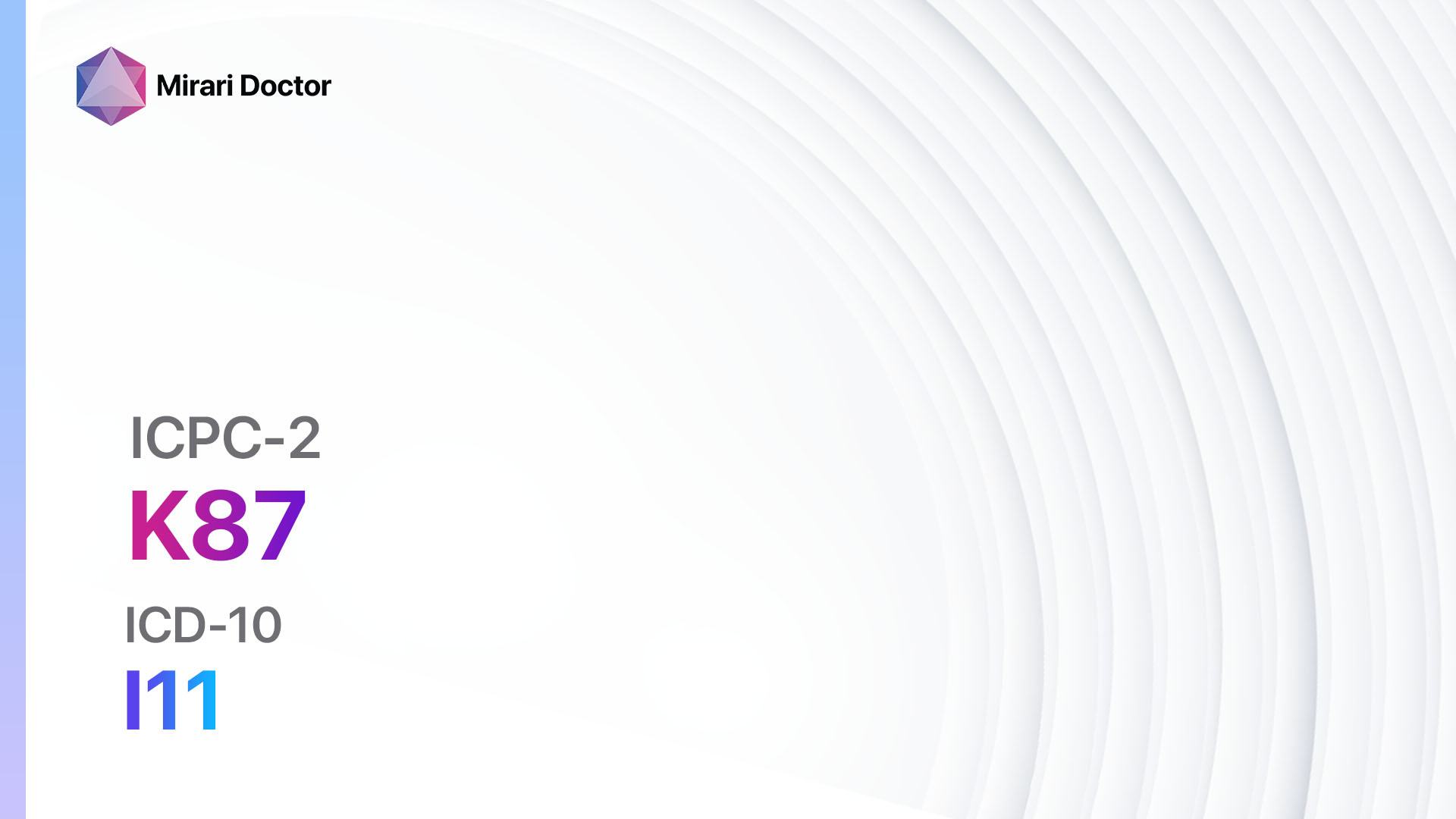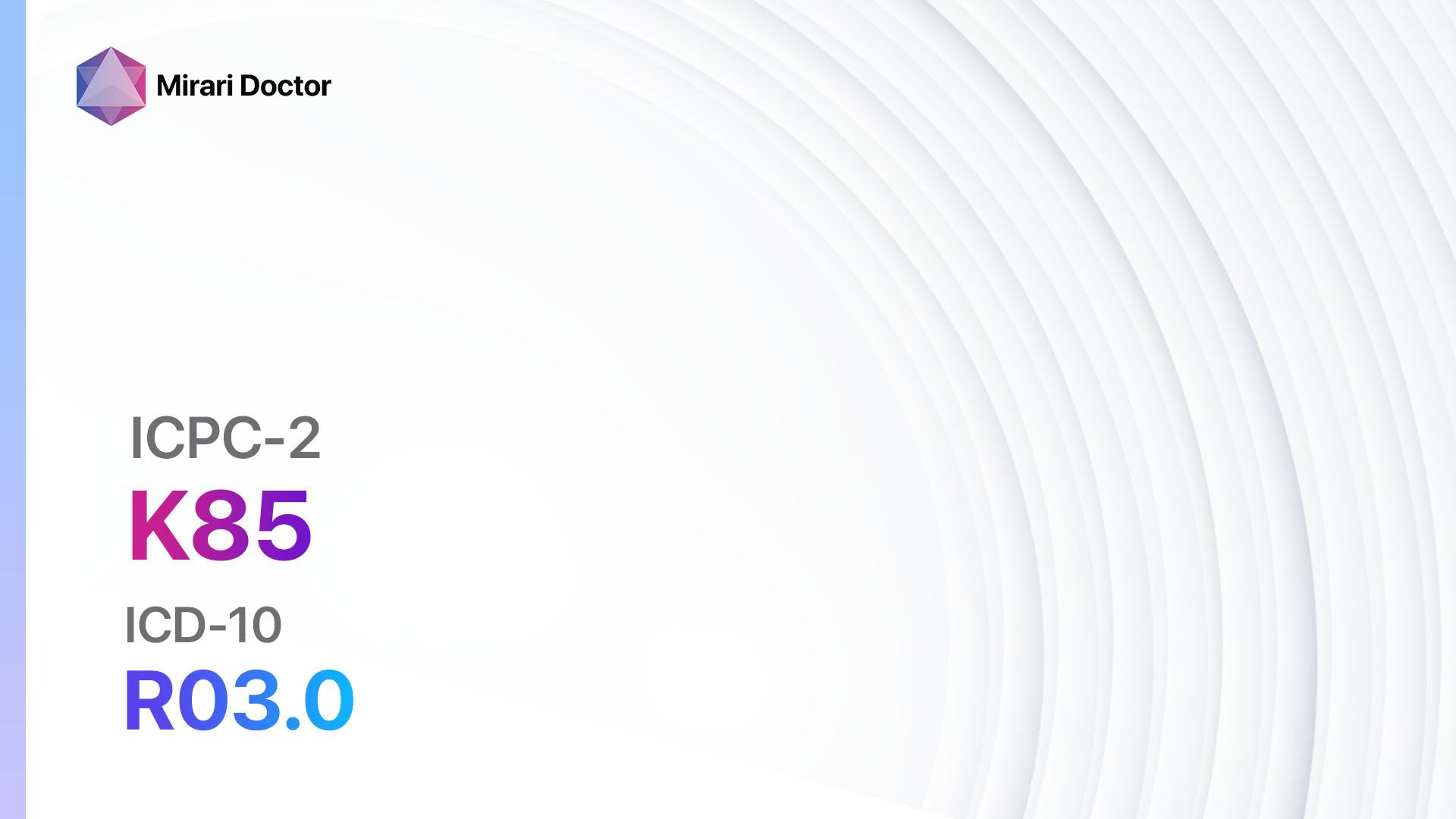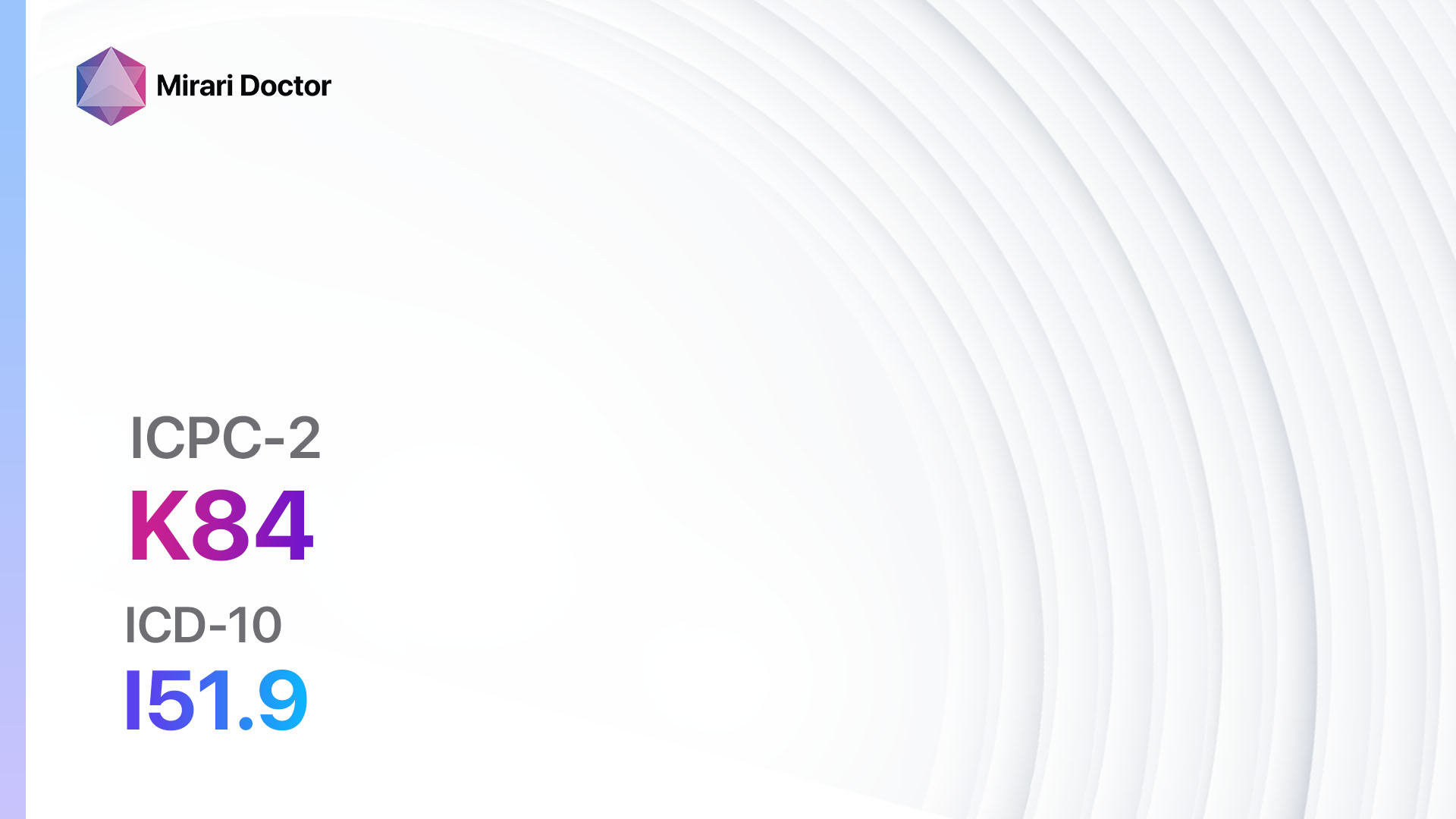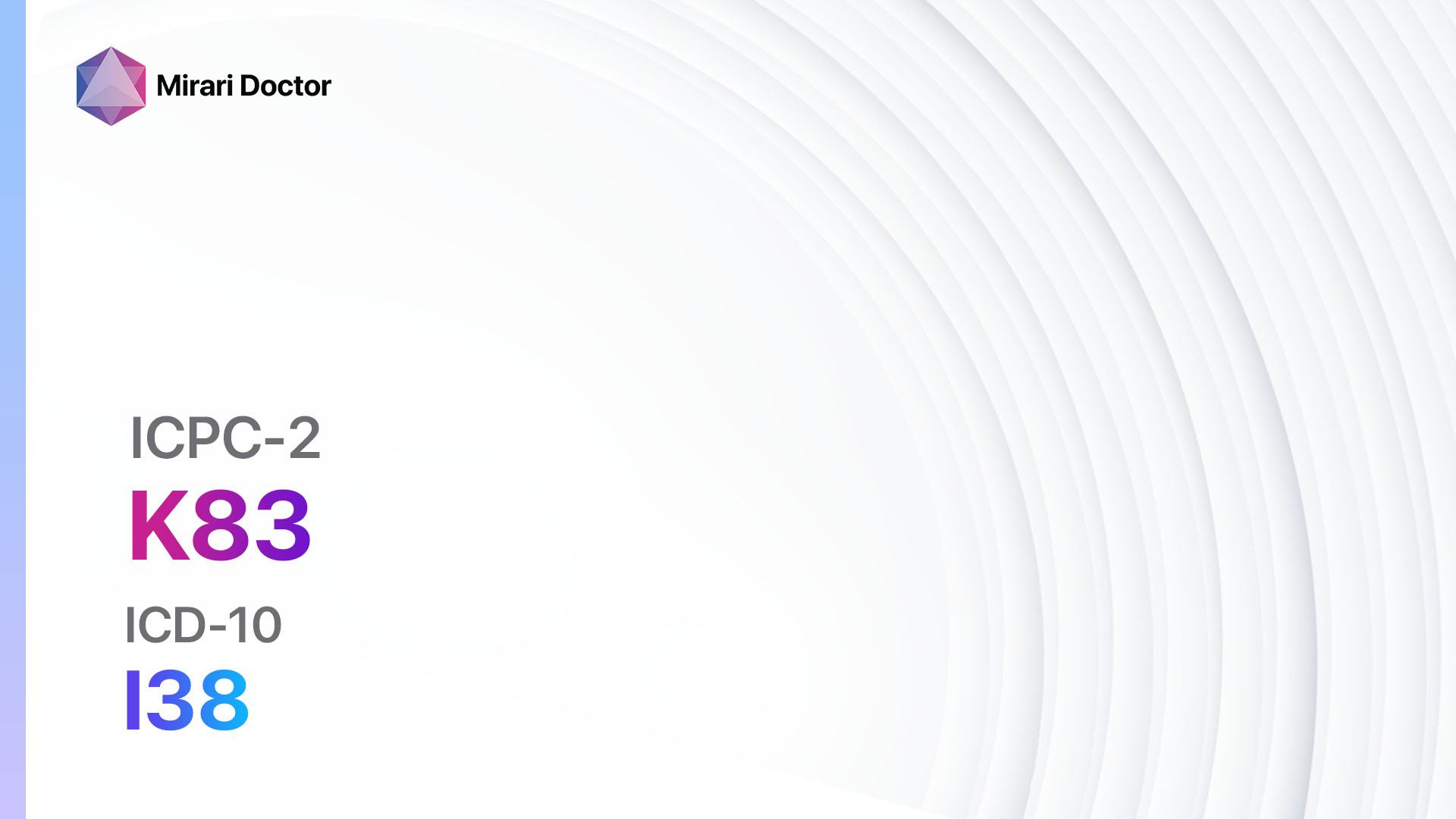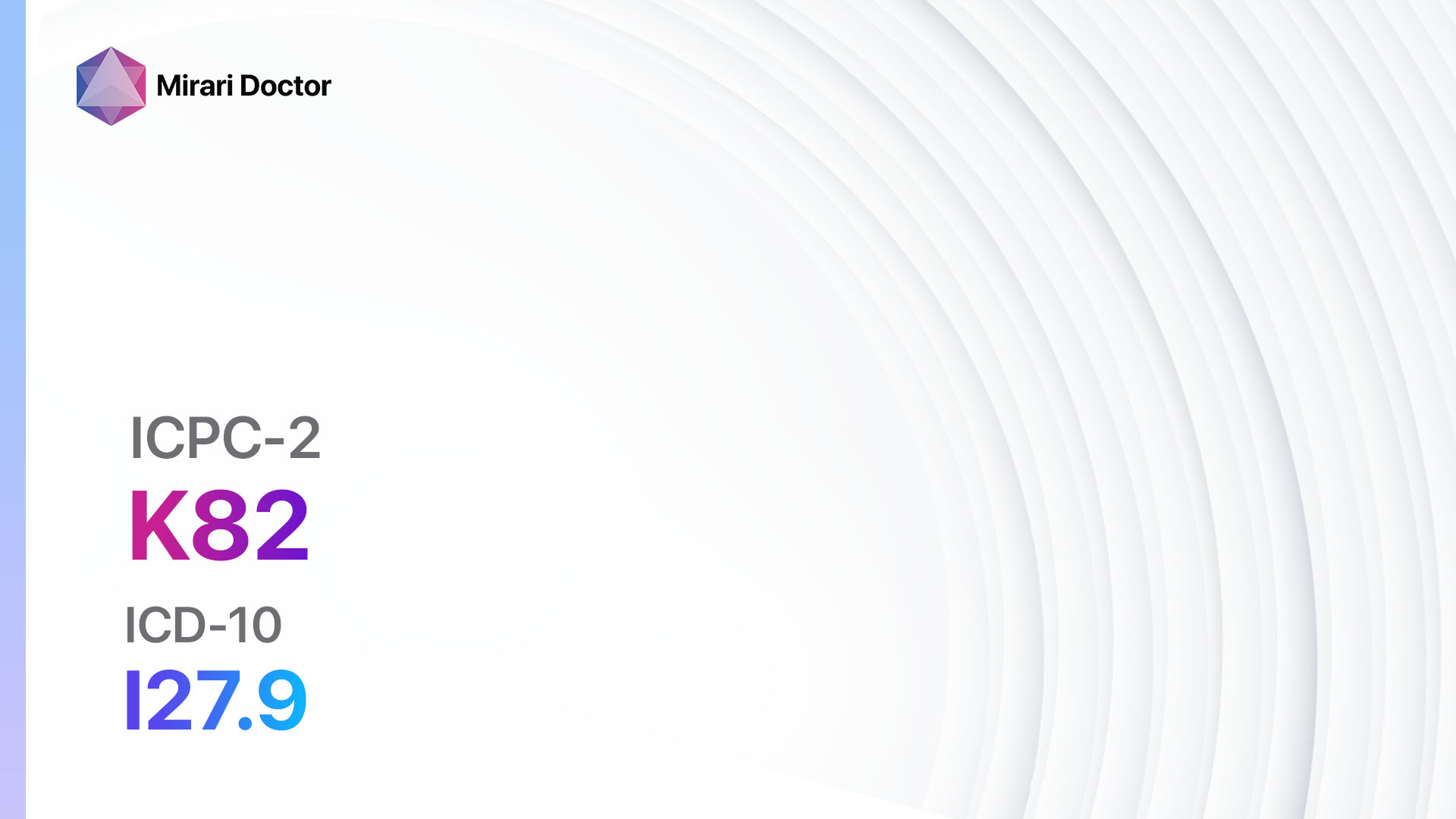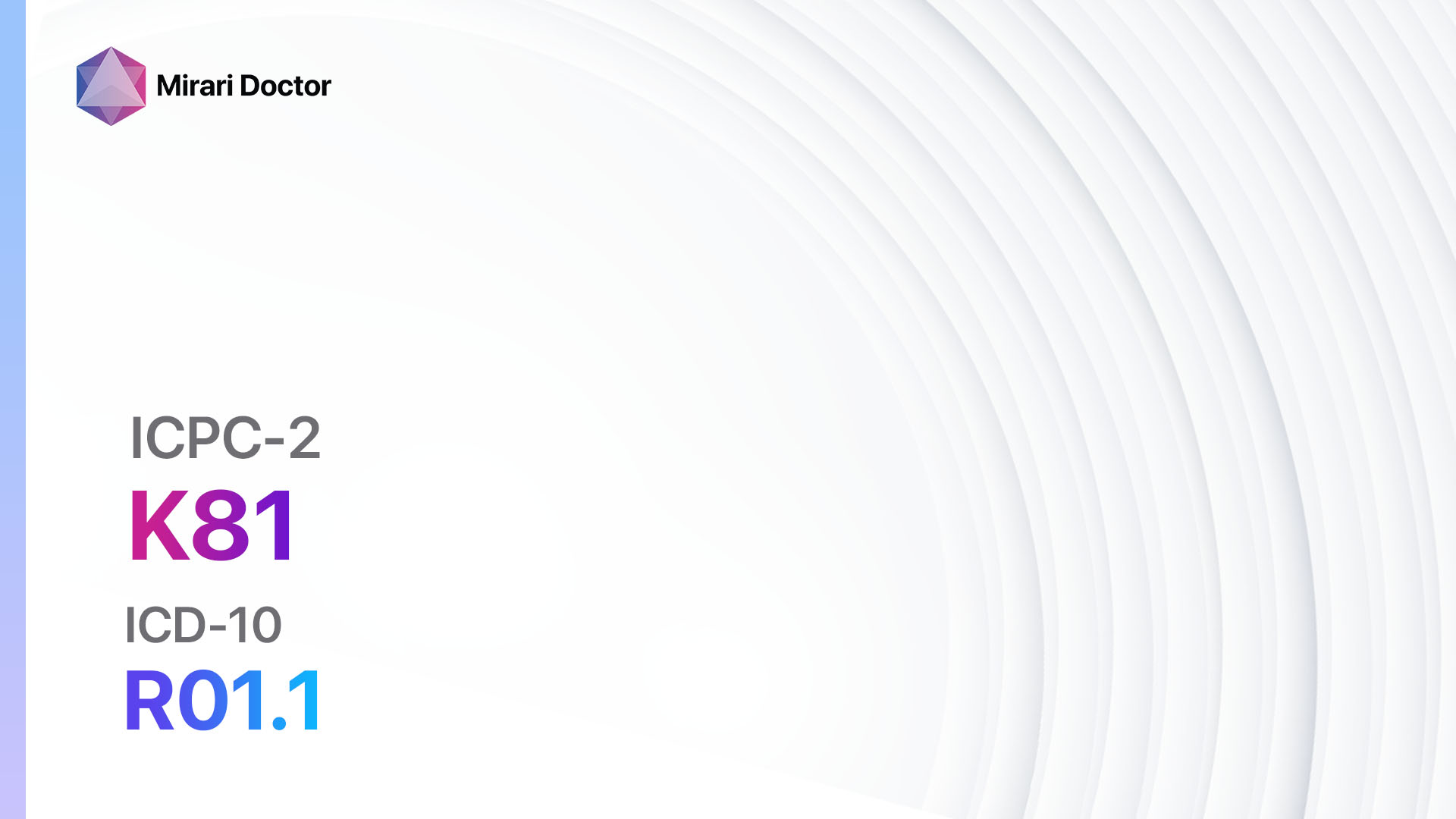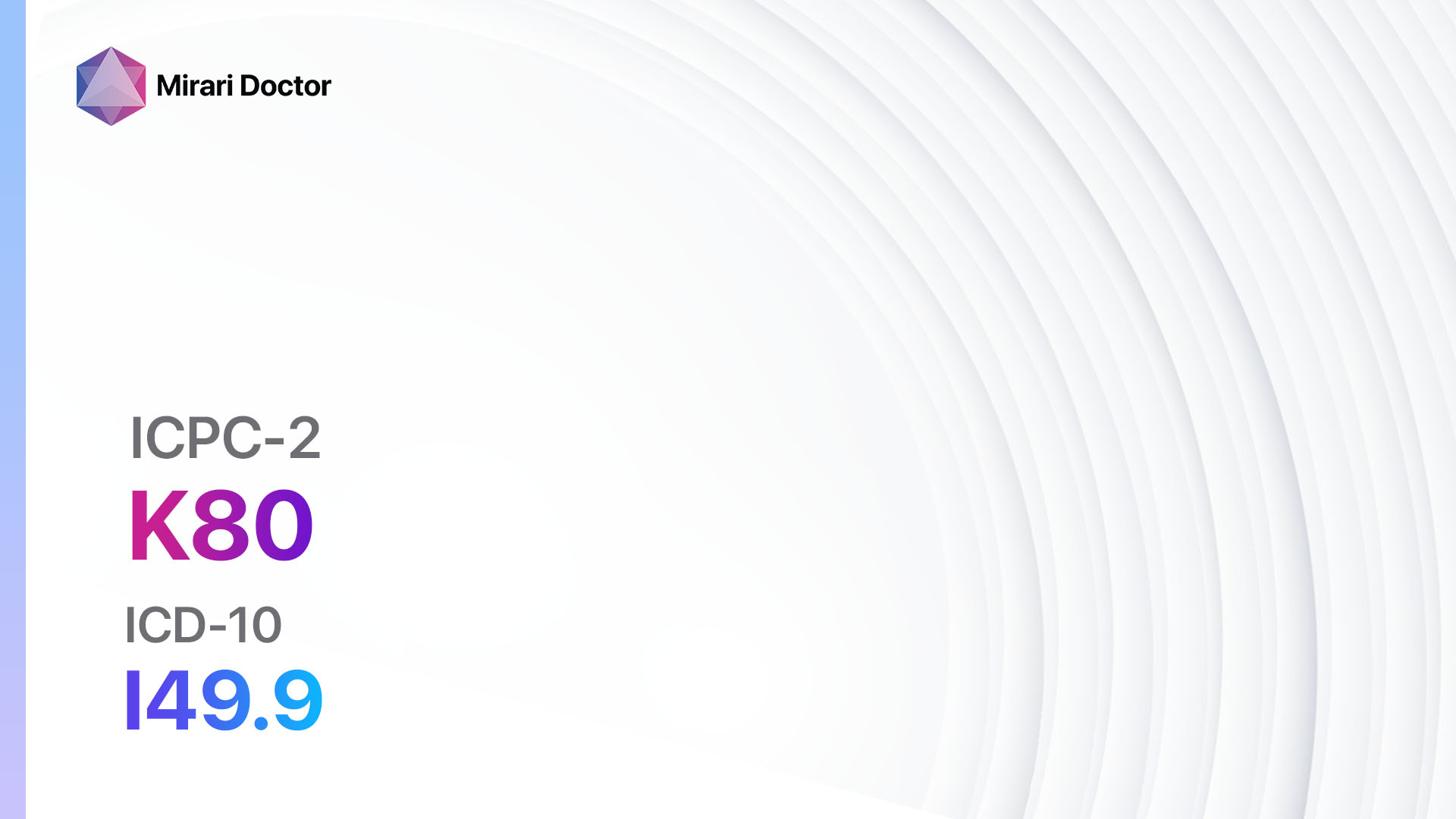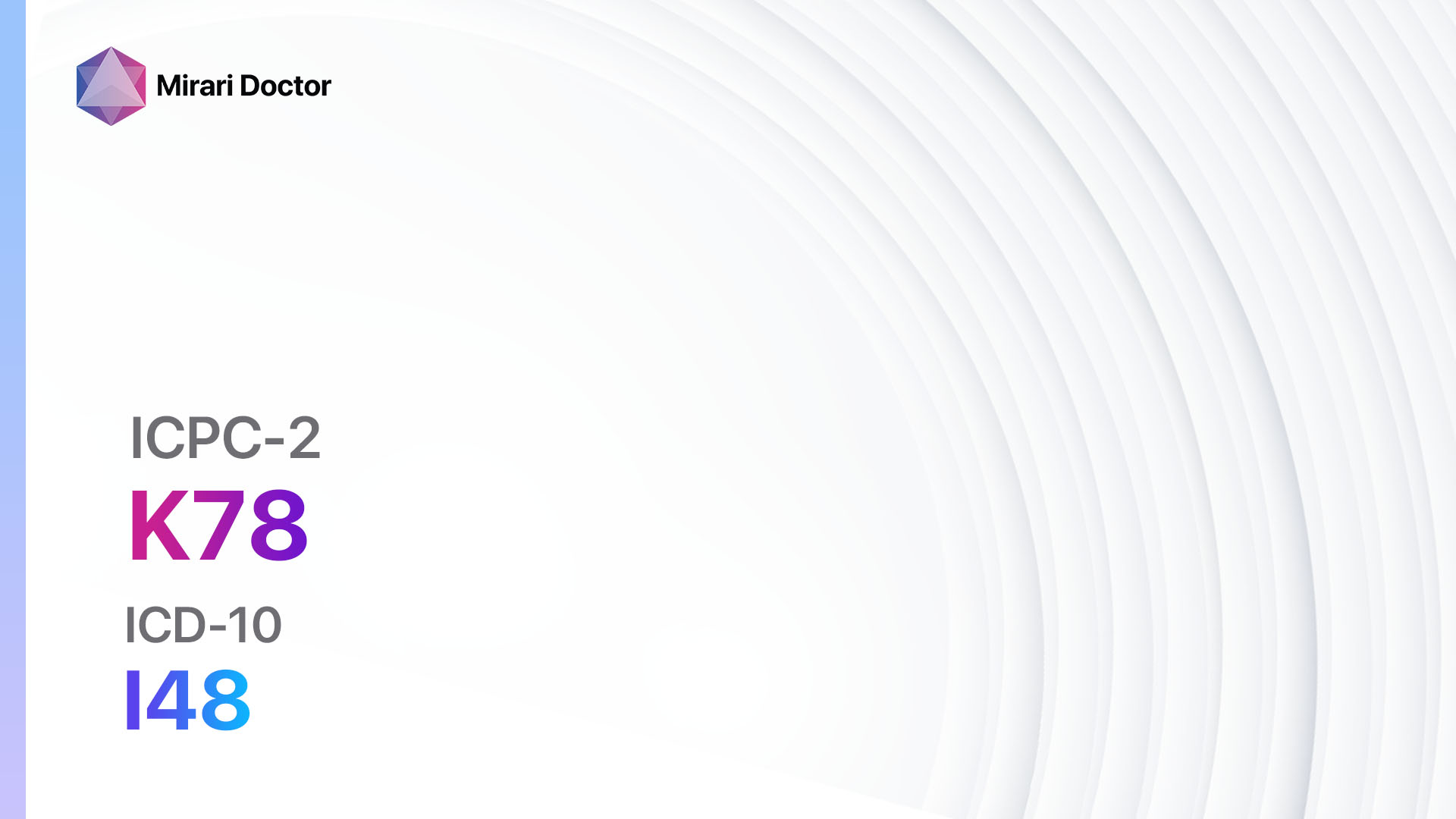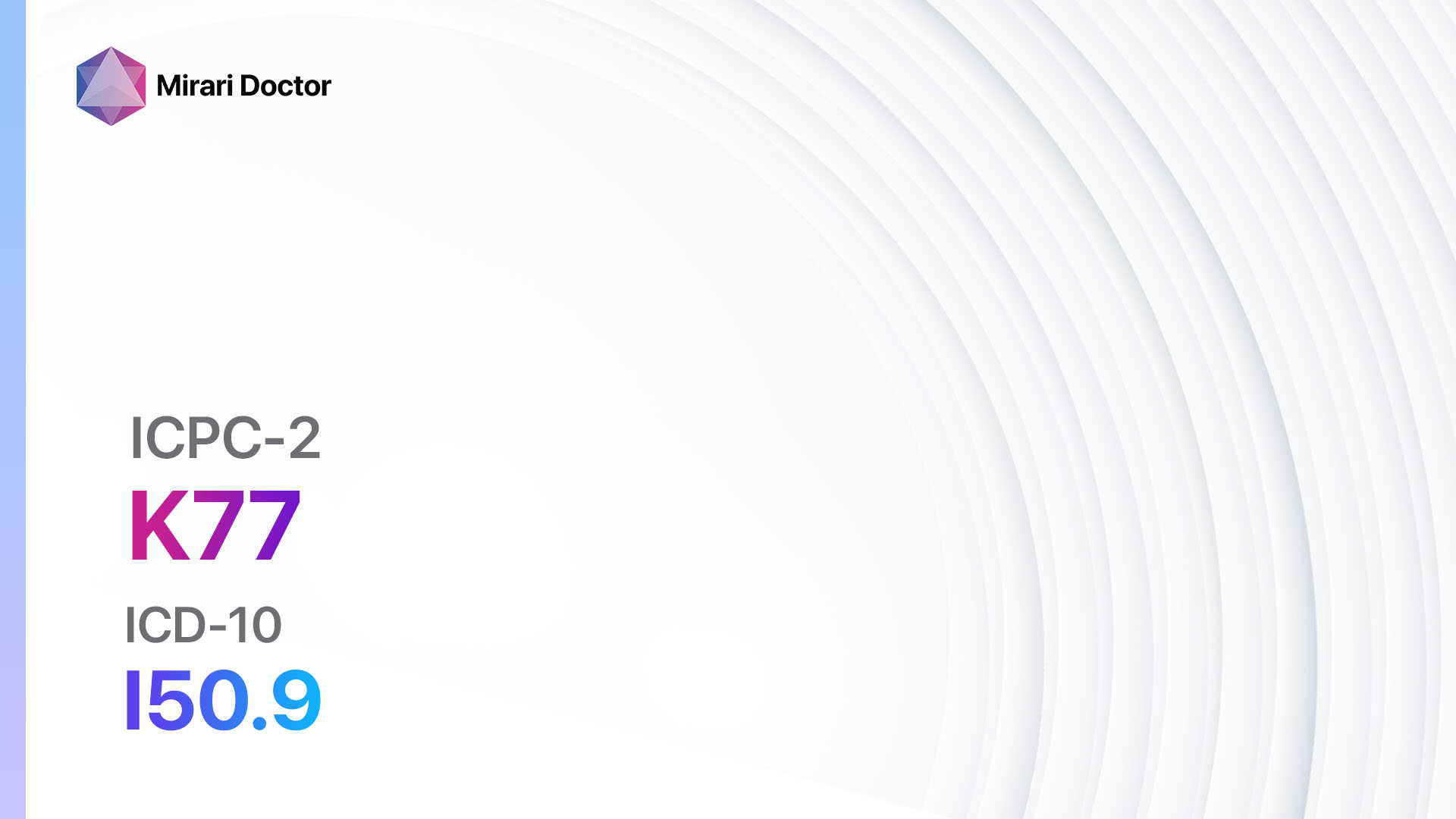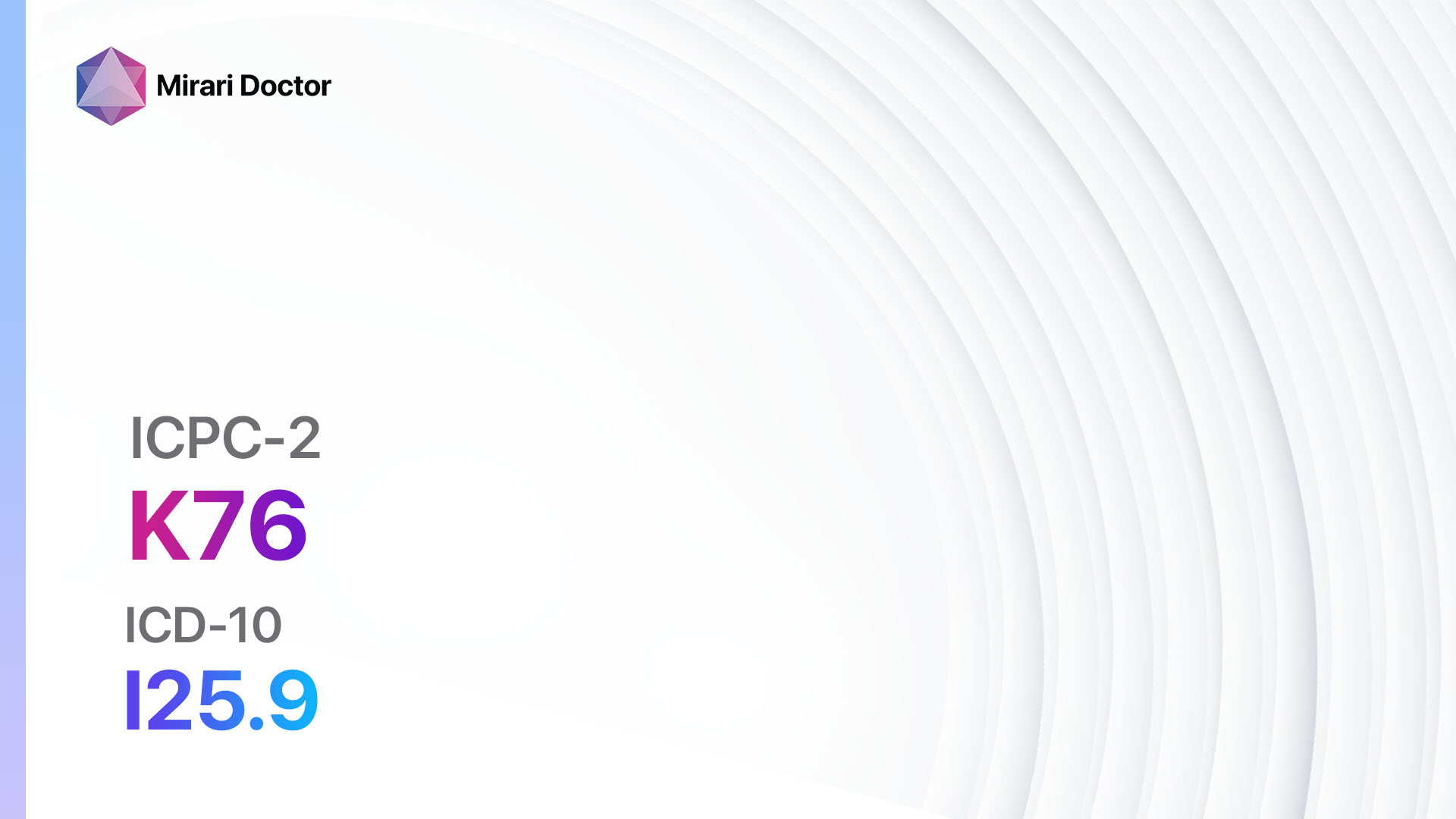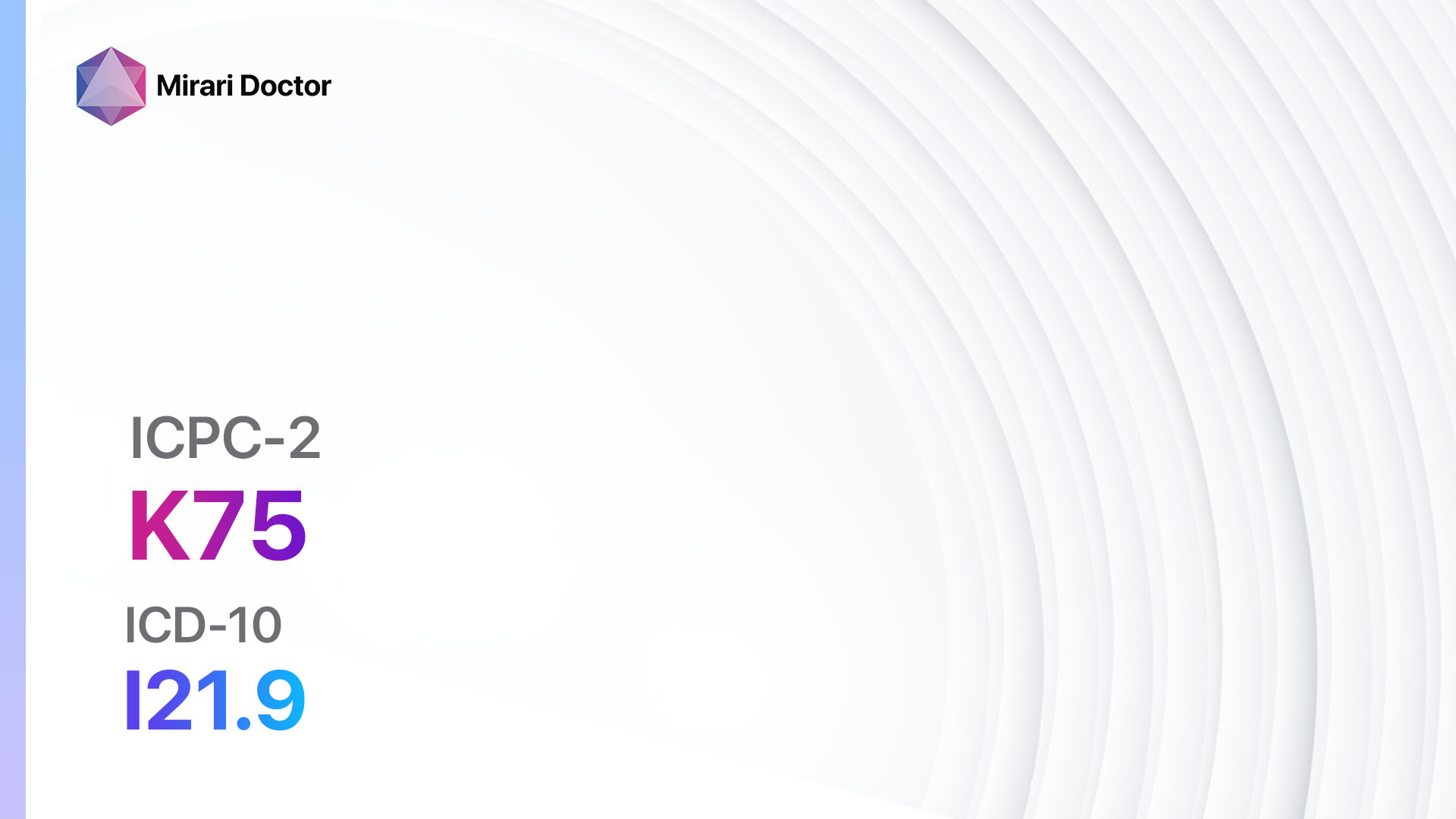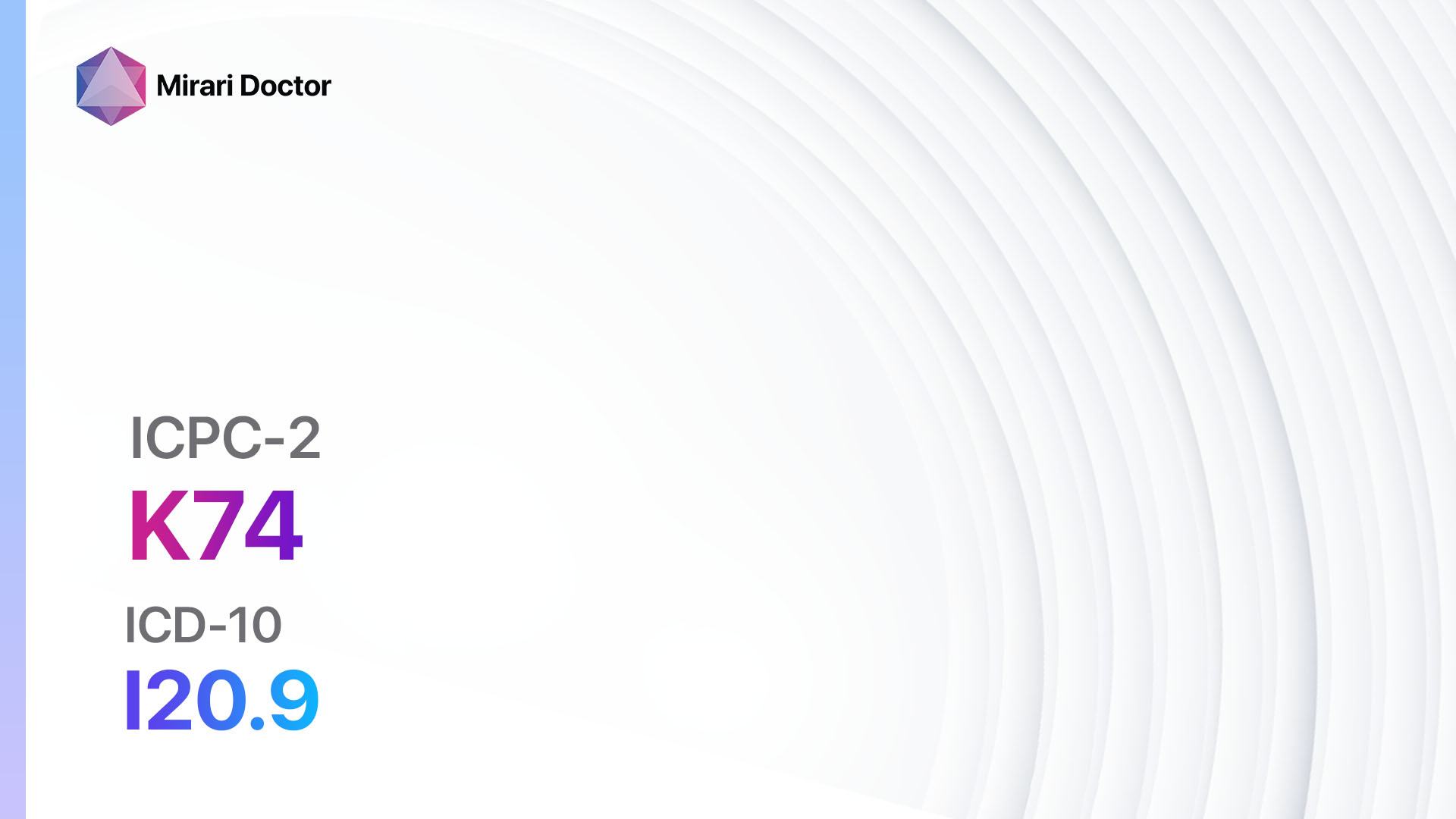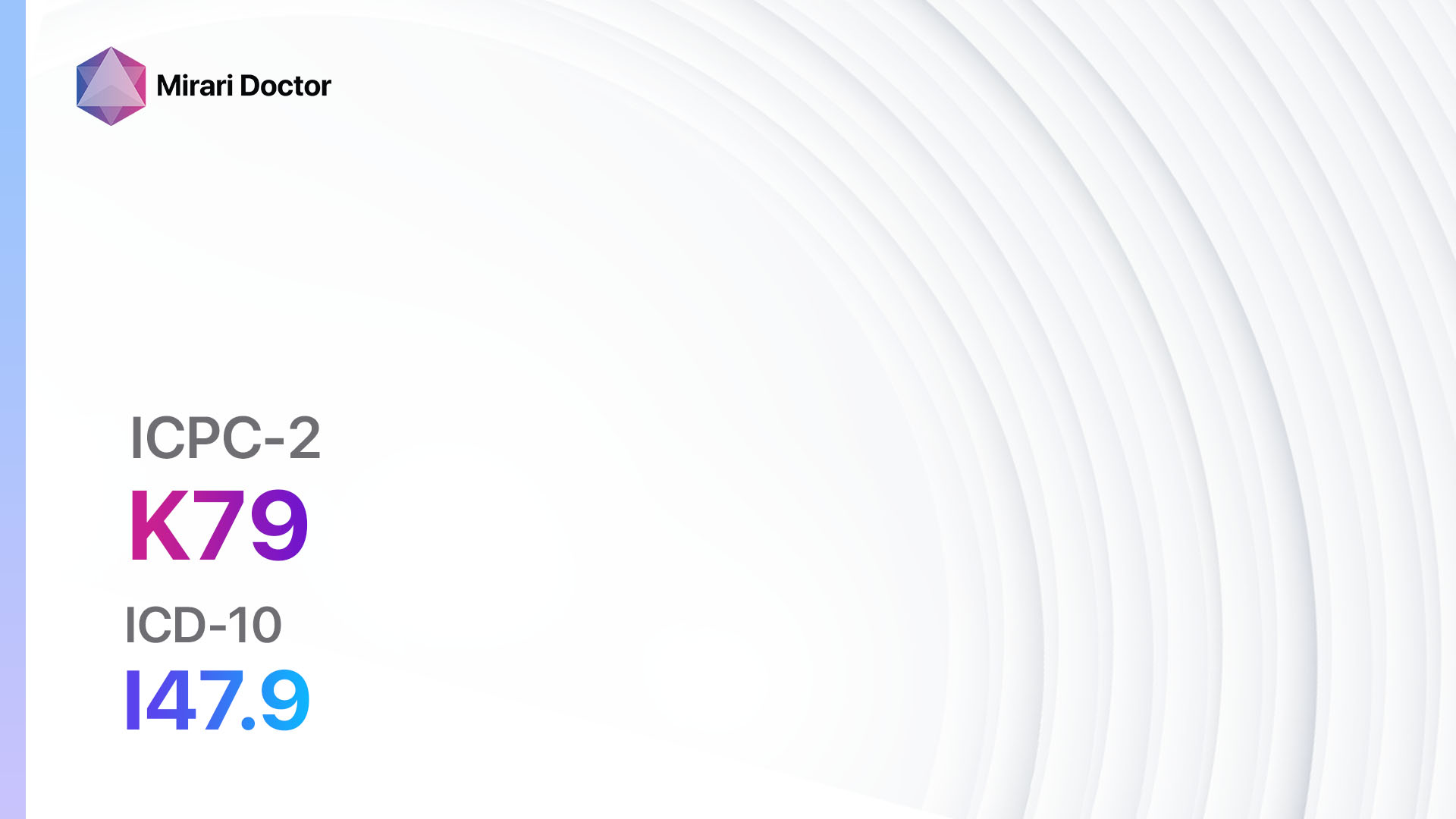
Introduction
Paroxysmal tachycardia is a condition characterized by sudden episodes of rapid heart rate. It can be caused by various factors and may lead to symptoms such as palpitations, dizziness, and shortness of breath. The aim of this guide is to provide an overview of the symptoms, causes, diagnostic steps, possible interventions, and lifestyle interventions for paroxysmal tachycardia.
Codes
- ICPC-2 Code: K79 Paroxysmal tachycardia[1]
- ICD-10 Code: I47.9 Paroxysmal tachycardia, unspecified[2][3]
Symptoms
- Palpitations: Sensation of a rapid or irregular heartbeat.[4]
- Dizziness: Feeling lightheaded or faint.[4]
- Shortness of breath: Difficulty breathing or catching one’s breath.[4]
- Chest discomfort: Pain, pressure, or tightness in the chest.[4]
- Fatigue: Feeling tired or exhausted.[4]
Causes
- Abnormal electrical pathways in the heart.[5]
- Heart conditions, such as coronary artery disease or heart failure.[5]
- Thyroid disorders.[5]
- Stimulants, such as caffeine or nicotine.[5]
- Emotional stress or anxiety.[5]
Diagnostic Steps
Medical History
- Gather information about the patient’s symptoms, including the frequency, duration, and triggers of paroxysmal tachycardia episodes.[6]
- Identify any underlying medical conditions, such as heart disease or thyroid disorders.[6]
- Assess the patient’s lifestyle habits, including caffeine and nicotine consumption.[6]
Physical Examination
- Measure the patient’s heart rate and blood pressure.[6]
- Listen to the heart for any abnormal sounds or rhythms.[6]
- Check for signs of heart disease, such as swollen ankles or a rapid pulse.[6]
Laboratory Tests
- Complete blood count (CBC): To check for anemia or infection.[7]
- Thyroid function tests: To evaluate thyroid hormone levels.[7]
- Electrolyte panel: To assess the levels of potassium, sodium, and other electrolytes.[7]
- Cardiac enzymes: To rule out a heart attack as the cause of symptoms.[7]
Diagnostic Imaging
- Electrocardiogram (ECG): To record the electrical activity of the heart and identify any abnormal rhythms.[8]
- Holter monitor: A portable device that records the heart’s activity over a 24-hour period.[8]
- Echocardiogram: Uses sound waves to create images of the heart’s structure and function.[8]
- Stress test: Measures the heart’s response to physical exertion.[8]
Other Tests
- Electrophysiology study: Invasive procedure to evaluate the heart’s electrical system and identify the source of abnormal rhythms.[9]
- Tilt table test: Assessing the heart’s response to changes in body position.[9]
- Genetic testing: To identify any inherited conditions that may contribute to paroxysmal tachycardia.[9]
Follow-up and Patient Education
- Schedule regular follow-up appointments to monitor the patient’s condition and adjust treatment as needed.[10]
- Educate the patient about triggers to avoid, such as caffeine or stress.[10]
- Provide information on lifestyle modifications and self-care measures to manage symptoms.[10]
Possible Interventions
Traditional Interventions
Medications:
Top 5 drugs for Paroxysmal tachycardia:
- Beta-blockers (e.g., Metoprolol, Atenolol):
- Cost: Generic versions are typically <$30/month.
- Contraindications: Severe bradycardia, heart block.
- Side effects: Fatigue, dizziness, bradycardia.
- Severe side effects: Bronchospasm, heart failure.
- Drug interactions: Calcium channel blockers, insulin.
- Warning: Should not be abruptly stopped.
- Calcium channel blockers (e.g., Verapamil, Diltiazem):
- Cost: Generic versions can be $10-$50/month.
- Contraindications: Severe hypotension, heart failure.
- Side effects: Constipation, dizziness, headache.
- Severe side effects: Heart block, low blood pressure.
- Drug interactions: Beta-blockers, grapefruit juice.
- Warning: Regular blood pressure monitoring required.
- Antiarrhythmic agents (e.g., Amiodarone, Propafenone):
- Cost: Generic versions can be $10-$100/month.
- Contraindications: Severe bradycardia, heart block.
- Side effects: Fatigue, dizziness, nausea.
- Severe side effects: Pulmonary toxicity, liver damage.
- Drug interactions: Beta-blockers, grapefruit juice.
- Warning: Regular monitoring of liver and lung function required.
- Adenosine:
- Cost: Varies depending on the formulation.
- Contraindications: Asthma, heart block.
- Side effects: Flushing, chest discomfort, shortness of breath.
- Severe side effects: Severe bradycardia, hypotension.
- Drug interactions: Methylxanthines, dipyridamole.
- Warning: Should be administered in a monitored setting.
- Digoxin:
- Cost: Generic versions can be $10-$50/month.
- Contraindications: Ventricular fibrillation, heart block.
- Side effects: Nausea, vomiting, visual disturbances.
- Severe side effects: Ventricular arrhythmias, toxicity.
- Drug interactions: Diuretics, verapamil.
- Warning: Regular monitoring of digoxin levels required.
Alternative Drugs:
- Sotalol: A beta-blocker with antiarrhythmic properties.
- Flecainide: An antiarrhythmic agent used for certain types of tachycardia.
- Propafenone: An antiarrhythmic agent used for supraventricular tachycardia.
- Ivabradine: A medication that slows the heart rate by inhibiting the funny current in the sinoatrial node.
- Procainamide: An antiarrhythmic agent used for various types of tachycardia.
Surgical Procedures:
- Catheter ablation: Invasive procedure to destroy the abnormal heart tissue responsible for the tachycardia.
- Pacemaker implantation: Device implanted to regulate the heart’s rhythm and prevent episodes of tachycardia.
- Implantable cardioverter-defibrillator (ICD) implantation: Device implanted to monitor and correct life-threatening arrhythmias.
Alternative Interventions
- Acupuncture: May help regulate the autonomic nervous system and reduce stress. Cost: $60-$120 per session.
- Yoga and meditation: Can promote relaxation and reduce anxiety. Cost: Varies depending on the class or instructor.
- Herbal supplements: Some herbs, such as hawthorn or motherwort, may have potential benefits for heart health. Cost: Varies depending on the specific supplement.
- Biofeedback: Teaches patients to control their heart rate and reduce stress. Cost: $50-$100 per session.
- Stress management techniques: Such as deep breathing exercises or progressive muscle relaxation. Cost: Varies depending on the method or program.
Lifestyle Interventions
- Avoid triggers: Identify and avoid factors that may trigger episodes of paroxysmal tachycardia, such as caffeine, nicotine, or emotional stress.
- Regular exercise: Engage in moderate aerobic exercise, such as walking or swimming, to improve cardiovascular health. Cost: Varies depending on the chosen activity.
- Healthy diet: Follow a balanced diet rich in fruits, vegetables, whole grains, and lean proteins. Cost: Varies depending on food choices.
- Stress reduction techniques: Practice relaxation techniques, such as deep breathing or mindfulness, to manage stress levels. Cost: Varies depending on the method or program.
- Adequate sleep: Ensure sufficient sleep duration and quality to support overall health and well-being. Cost: Varies depending on individual sleep needs.
It is important to note that the cost ranges provided are approximate and may vary depending on the location and availability of the interventions.
Mirari Cold Plasma Alternative Intervention
Understanding Mirari Cold Plasma
- Safe and Non-Invasive Treatment: Mirari Cold Plasma is a safe and non-invasive treatment option for various skin conditions. It does not require incisions, minimizing the risk of scarring, bleeding, or tissue damage.
- Efficient Extraction of Foreign Bodies: Mirari Cold Plasma facilitates the removal of foreign bodies from the skin by degrading and dissociating organic matter, allowing easier access and extraction.
- Pain Reduction and Comfort: Mirari Cold Plasma has a local analgesic effect, providing pain relief during the treatment, making it more comfortable for the patient.
- Reduced Risk of Infection: Mirari Cold Plasma has antimicrobial properties, effectively killing bacteria and reducing the risk of infection.
- Accelerated Healing and Minimal Scarring: Mirari Cold Plasma stimulates wound healing and tissue regeneration, reducing healing time and minimizing the formation of scars.
Mirari Cold Plasma Prescription
Video instructions for using Mirari Cold Plasma Device – K79 Paroxysmal tachycardia (ICD-10:I47.9)
| Mild | Moderate | Severe |
| Mode setting: 1 (Infection) Location: 5 (Lungs) Morning: 15 minutes, Evening: 15 minutes |
Mode setting: 1 (Infection) Location: 5 (Lungs) Morning: 30 minutes, Lunch: 30 minutes, Evening: 30 minutes |
Mode setting: 1 (Infection) Location: 5 (Lungs) Morning: 30 minutes, Lunch: 30 minutes, Evening: 30 minutes |
| Mode setting: 2 (Wound Healing) Location: 5 (Lungs) Morning: 15 minutes, Evening: 15 minutes |
Mode setting: 2 (Wound Healing) Location: 5 (Lungs) Morning: 30 minutes, Lunch: 30 minutes, Evening: 30 minutes |
Mode setting: 2 (Wound Healing) Location: 5 (Lungs) Morning: 30 minutes, Lunch: 30 minutes, Evening: 30 minutes |
| Mode setting: 7 (Immunotherapy) Location: 1 (Sacrum) Morning: 15 minutes, Evening: 15 minutes |
Mode setting: 7 (Immunotherapy) Location: 1 (Sacrum) Morning: 30 minutes, Lunch: 30 minutes, Evening: 30 minutes |
Mode setting: 7 (Immunotherapy) Location: 1 (Sacrum) Morning: 30 minutes, Lunch: 30 minutes, Evening: 30 minutes |
| Mode setting: 7 (Immunotherapy) Location: 4 (Heart, Bile & Pancreas) Morning: 15 minutes, Evening: 15 minutes |
Mode setting: 7 (Immunotherapy) Location: 4 (Heart, Bile & Pancreas) Morning: 30 minutes, Lunch: 30 minutes, Evening: 30 minutes |
Mode setting:7 (Immunotherapy) Location: 4 (Heart, Bile & Pancreas) Morning: 30 minutes, Lunch: 30 minutes, Evening: 30 minutes |
| otal Morning: 60 minutes approx. $10 USD, Evening: 60 minutes approx. $10 USD |
Total Morning: 120 minutes approx. $20 USD, Lunch: 120 minutes approx. $20 USD, Evening: 120 minutes approx. $20 USD, |
Total Morning: 120 minutes approx. $20 USD, Lunch: 120 minutes approx. $20 USD, Evening: 120 minutes approx. $20 USD, |
| Usual treatment for 7-60 days approx. $140 USD – $1200 USD | Usual treatment for 6-8 weeks approx. $2,520 USD – $3,360 USD |
Usual treatment for 3-6 months approx. $5,400 USD – $10,800 USD
|
 |
|
Use the Mirari Cold Plasma device to treat Paroxysmal tachycardia effectively.
WARNING: MIRARI COLD PLASMA IS DESIGNED FOR THE HUMAN BODY WITHOUT ANY ARTIFICIAL OR THIRD PARTY PRODUCTS. USE OF OTHER PRODUCTS IN COMBINATION WITH MIRARI COLD PLASMA MAY CAUSE UNPREDICTABLE EFFECTS, HARM OR INJURY. PLEASE CONSULT A MEDICAL PROFESSIONAL BEFORE COMBINING ANY OTHER PRODUCTS WITH USE OF MIRARI.
Step 1: Cleanse the Skin
- Start by cleaning the affected area of the skin with a gentle cleanser or mild soap and water. Gently pat the area dry with a clean towel.
Step 2: Prepare the Mirari Cold Plasma device
- Ensure that the Mirari Cold Plasma device is fully charged or has fresh batteries as per the manufacturer’s instructions. Make sure the device is clean and in good working condition.
- Switch on the Mirari device using the power button or by following the specific instructions provided with the device.
- Some Mirari devices may have adjustable settings for intensity or treatment duration. Follow the manufacturer’s instructions to select the appropriate settings based on your needs and the recommended guidelines.
Step 3: Apply the Device
- Place the Mirari device in direct contact with the affected area of the skin. Gently glide or hold the device over the skin surface, ensuring even coverage of the area experiencing.
- Slowly move the Mirari device in a circular motion or follow a specific pattern as indicated in the user manual. This helps ensure thorough treatment coverage.
Step 4: Monitor and Assess:
- Keep track of your progress and evaluate the effectiveness of the Mirari device in managing your Paroxysmal tachycardia. If you have any concerns or notice any adverse reactions, consult with your health care professional.
Note
This guide is for informational purposes only and should not replace the advice of a medical professional. Always consult with your healthcare provider or a qualified medical professional for personal advice, diagnosis, or treatment. Do not solely rely on the information presented here for decisions about your health. Use of this information is at your own risk. The authors of this guide, nor any associated entities or platforms, are not responsible for any potential adverse effects or outcomes based on the content.
Mirari Cold Plasma System Disclaimer
- Purpose: The Mirari Cold Plasma System is a Class 2 medical device designed for use by trained healthcare professionals. It is registered for use in Thailand and Vietnam. It is not intended for use outside of these locations.
- Informational Use: The content and information provided with the device are for educational and informational purposes only. They are not a substitute for professional medical advice or care.
- Variable Outcomes: While the device is approved for specific uses, individual outcomes can differ. We do not assert or guarantee specific medical outcomes.
- Consultation: Prior to utilizing the device or making decisions based on its content, it is essential to consult with a Certified Mirari Tele-Therapist and your medical healthcare provider regarding specific protocols.
- Liability: By using this device, users are acknowledging and accepting all potential risks. Neither the manufacturer nor the distributor will be held accountable for any adverse reactions, injuries, or damages stemming from its use.
- Geographical Availability: This device has received approval for designated purposes by the Thai and Vietnam FDA. As of now, outside of Thailand and Vietnam, the Mirari Cold Plasma System is not available for purchase or use.
References
- World Organization of Family Doctors (WONCA). ICPC-2: International Classification of Primary Care. 2nd ed. Oxford University Press; 1998.
- Centers for Medicare & Medicaid Services. ICD-10-CM Official Guidelines for Coding and Reporting. https://www.cms.gov/medicare/icd-10/2023-icd-10-cm
- Unbound Medicine. I47.9 – Paroxysmal tachycardia, unspecified. https://www.unboundmedicine.com/icd/view/ICD-10-CM/865324/all/I47_9___Paroxysmal_tachycardia__unspecified
- MedlinePlus. Paroxysmal supraventricular tachycardia (PSVT). https://medlineplus.gov/ency/article/000183.htm
- Medscape. Paroxysmal Supraventricular Tachycardia Clinical Presentation. https://emedicine.medscape.com/article/156670-clinical
- MyActiveHealth. Medical History and Physical Exam for a Fast Heart Rate. https://www.myactivehealth.com/hwcontent/content/testdetail/ps1507.html
- Medscape. Paroxysmal Supraventricular Tachycardia Workup. https://emedicine.medscape.com/article/156670-workup
- WebMD. Tachycardia: Symptoms, Causes, Diagnosis, Treatment. https://www.webmd.com/heart-disease/atrial-fibrillation/what-are-the-types-of-tachycardia
- StatPearls. Paroxysmal Atrial Tachycardia. https://www.ncbi.nlm.nih.gov/books/NBK538317/
- Medscape. Paroxysmal Supraventricular Tachycardia Treatment & Management. https://emedicine.medscape.com/article/156670-treatment
Related articles
Made in USA


